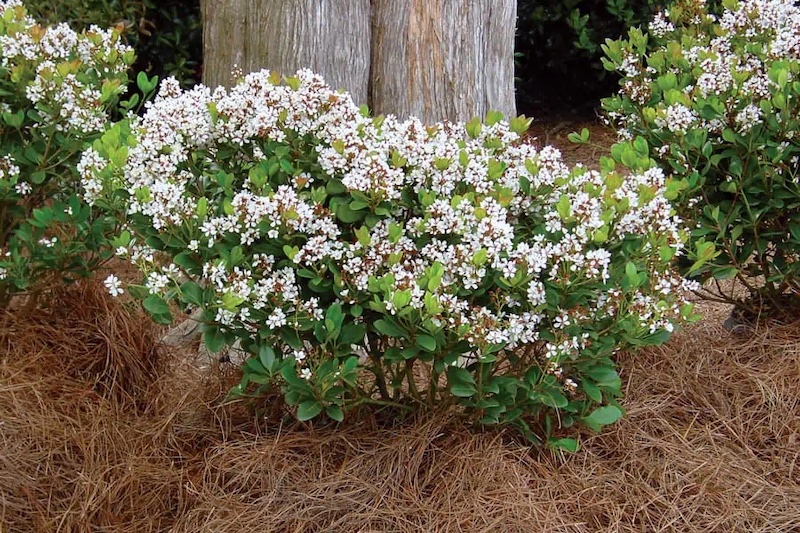Indian Hawthorn is an easy-to-grow evergreen shrub. The flowers in the spring and berries through the fall and winter add to the year-round good looks of this shrub. Scientifically known as Rhaphiolepis indica, this shrub requires little maintenance when planted in the right location with good draining soil and full sun exposure.

What You Need To Plant Indian Hawthorn
- Transplanting spade or another small-headed shovel
- Nearby water source
- Organic material to use as mulch
- Granular organic all-purpose fertilizer
- Organic compost
Where to Plant Indian Hawthorn
Choose a location that provides at least 6 hours of full sun exposure and has well-draining soil year-round. The pH of the soil can range from slightly acidic to slightly alkaline. This shrub is not particular about soil type, although very heavy clay soil should be amended to help it drain well. Mix in 2-3 inches of compost in the area where the shrub will be planted. Repeated annual mulching with compost will also improve soil drainage over the years.
Indian Hawthorn Spacing
Indian Hawthorn varieties typically create a low-mounding profile with a spread of 3-4 feet. Space plants 30 inches apart when planting multiple shrubs as a hedge or ground cover. Shrubs planted in containers will require a pot that is several inches larger than the rootball. Typically 18-inch pots and larger will provide many seasons of growth for Indian Hawthorn. The root system of Indian Hawthorn is very fibrous and not considered invasive or problematic when planted near building foundations or over utility lines.
Steps To Plant Indian Hawthorn
Step 1 - Dig the planting hole twice as wide and as deep as the rootball. This allows the roots to spread out comfortably.
Step 2 - Gently take the shrub out of the pot and tease the roots apart lightly. Root-bound plants will have a difficult time establishing a good root system.
Step 3 - Place the rootball so that it is just level with the surface of the soil; replace the soil around the root ball making sure to fill in any large air pockets.
Step 4 - Water the soil and root zone well. This helps to settle the plant into the ground and remove any remaining air pockets.
Step 5 - Mulch around the base of the shrub with 2-3 inches of organic material or compost. Avoid getting mulch on the plant or against the base of the stems. Mulching after watering helps to hold moisture in the soil longer while also suppressing weeds.
When to Plant Indian Hawthorn
Indian Hawthorn shrubs can be successfully planted either in the spring or fall depending on your growing zone. Gardeners in areas with rainy summers will have an easier time establishing the shrubs with spring planting. Gardeners in the warmer growing areas may want to wait until the cooler months of fall to plant new shrubs. Consistent watering will be the most important factor in establishing a good root system no matter what time of year you plant.
Transplanting Indian Hawthorn
Evergreen shrubs are generally easy to relocate and transplant when required. Late winter or early spring, as soon as the soil can be worked, is the best time to move Indian Hawthorn. Make sure to extract as much of the rootball as possible to reduce the risk of transplant shock.
You can propagate Indian Hawthorn by stem cuttings. In the summer after blooming, take 6-inch cuttings of stems that have no wood growth yet. Remove the bottom leaves to expose a good section of the stem. Rooting hormone is not usually needed to develop roots, but can be used if desired. Plant the cutting in a pot of moist seed-starting mix or perlite. Keep the cutting well watered and in a few weeks, new growth should appear indicating that the cutting has rooted. Grow the cuttings in pots until they are a size that is easy to plant in the garden. This may take a couple of years of repotting into larger pots. Note that dividing Indian Hawthorn, a woody-stemmed shrub, is not possible.
 |
Author Robbin Small - Published 6-07-2023 |
